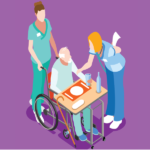 by Ann L. McNary, JD
by Ann L. McNary, JD
Ms. McNary is Senior Risk Manager at PRMS, Inc. in Arlington, Virginia.
Innov Clin Neurosci. 2017;14(3–4)41–44.
This ongoing column is dedicated to providing information to our readers on managing legal risks associated with medical practice. We invite questions from our readers. The answers are provided by PRMS, Inc. (www.prms.com), a manager of medical professional liability insurance programs with services that include risk management consultation, education and onsite risk management audits, and other resources to healthcare providers to help improve patient outcomes and reduce professional liability risk. The answers published in this column represent those of only one risk management consulting company. Other risk management consulting companies or insurance carriers may provide different advice, and readers should take this into consideration. The information in this column does not constitute legal advice. For legal advice, contact your personal attorney. Note: The information and recommendations in this article are applicable to physicians and other healthcare professionals so “clinician” is used to indicate all treatment team members.
Question
I am a psychiatrist who treats adult patients. I’ve noticed recently that I’m seeing a larger number of senior patients, and I have concerns about adequately meeting their needs and also avoiding risk. Do you have any suggestions for better managing an older patient population?
Answer
Given the aging baby-boomer population and the shortage of geriatric psychiatrists, more psychiatrists will find themselves being asked to see older patients and being exposed to the particular professional liability risks related to treating elderly patients. Therapeutic interventions require special attention to ensure the safety of elderly patients. Set forth below are four areas of consideration when treating elderly patients.
Recognize that an elderly patient’s capacity to give informed consent to treatment may be impaired. Generally speaking, a person may be said to possess capacity if he or she can communicate a choice, understand the relevant information, appreciate the medical consequences of the situation, and reason about treatment choices.[1] Capacity is often a fluid concept. Unless unconscious, a patient’s capacity may vary from day to day or even hour to hour. It may fluctuate as a function of the natural course of his or her illness, response to treatment, psychodynamic factors, metabolic status, intercurrent illnesses, or the effect of medications.[2]
A patient may lack the capacity to make some decisions but not others. For example, a patient may lack the capacity to manage his or her financial affairs but be perfectly capable of understanding and consenting to medical treatment. Or a patient may be able to execute some medical decisions, such as agreeing to take medication, but not others. The question then becomes whether the patient possesses the capacity to make a specific treatment decision.
Assess your patient’s ability to give informed consent, which may include a cognitive workup. There are two ways in which to assess capacity: by conducting a clinical interview or by using a formal assessment tool. When assessing capacity through the use of a clinical interview, it may also be necessary to conduct a physical examination, obtain lab work, and to consult with other healthcare providers who have previously treated the patient as well as family members. The clinical interview should contain components which allow you to do the following:
- Determine the ability of the patient to understand the proposed treatment and possible treatment alternatives.
- Determine the patient’s ability to apply given information regarding his or her own medical situation.
- Determine the ability of the patient to reason with the information in a manner supported by the facts and the patient’s own values.
- Determine the patient’s ability to communicate and express a choice clearly.[2]
If you determine that your patient is unable to provide consent to his or her treatment, then you must look to a surrogate decision-maker. In many instances, this person will be someone who has been appointed as the legal guardian of the patient or is someone who holds a power of attorney for healthcare decisions. If either of these is the case, the person claiming the right to make medical decisions should have legal documents granting such authority. You should request copies of these documents and also consider enlisting the assistance of your risk manager or attorney to determine the holder’s right to consent to treatment. Oftentimes, those holding a power of attorney will have only been granted the right to make financial decisions for the patient. If formal arrangements have not previously been made, then family members may be entitled to make decisions on behalf of the patient. As laws may vary from state to state, you should familiarize yourself with your state’s laws concerning substituted consent.
In some instances you may wish to discuss with patients the use of a Psychiatric Advance Directive (PAD), which are essentially advance directives planned for mental health decisions. PADs are gaining in popularity and psychiatrists can expect to see more of their use in the future. PADs may be used to name a healthcare proxy or may give specific instructions regarding the type of care a patient wishes to receive (or not receive) in the event of a psychiatric crisis. Psychiatric advocacy groups such as National Alliance on Mental Illness (NAMI) and Mental Health America support the use of PADS as a way to promote patient autonomy. The National Resource Center on Psychiatric Advance Directives is an excellent resource for finding state-specific information on the use of PADS.[3]
Recognize that therapeutic interventions require special attention to ensure the safety of elderly patients. PRMS Inc. claims data reflect that most lawsuits against psychiatrists include allegations involving medications. Careful medication management is particularly crucial when dealing with elderly patients who may have declining mental capacity and other co-occurring somatic conditions. The following is a list of suggestions for reducing risk and increasing patient safety when prescribing for elderly patients:
Before prescribing
- Understand and be knowledgeable about current intervention techniques and professional standards/guidelines regarding the treatment of elderly patients. One example of this is, the American Psychiatric Association (APA) Practice Guidelines on the Use of Antipsychotics in Patients with Dementia.[4]
- Make certain that you are aware of all medications your patient is currently taking. Ask the patient to bring in all medications he or she is currently taking each time the patient visits your office. This should also include over-the-counter medications and supplements.
- Remember to consult your state’s prescription monitoring program (PMP)—even if you are not technically required to check it. Elderly patients may not always accurately report all of their medications.
- Communicate with other treatment providers about the important aspects of the patient’s treatment—especially medications. Elderly patients are more likely to have co-occurring somatic conditions. Medications used for the treatment of those conditions can interact with other medications and place the patient at risk of serious injury.
- Be aware of the increased risk of injury from falls, to which elderly patients may be especially vulnerable when benzodiazepines and other sedating or performance-inhibiting medications are prescribed. Performance-inhibiting medications call for careful monitoring.
- Discuss with your patient the risks of the medications being prescribed, including risk of falls and driving impairment.
After prescribing
- Provide patients with written instructions on how and when to take medications. Make certain that you use clear, concise language and explain the purpose of each medication and its intended effect. Alert patients to dangerous side-effects.
- To the extent possible, simplify dosing regimens and encourage the use of devices, such as pill dispensers with reminder alarms or smartphone pill reminder apps, to aid patients in taking their medication.
- Encourage patients to fill prescriptions at only one location.
- Be aware of the increased risk of over- and under-medicating elderly patients. Monitoring patients for the continued effectiveness and safety of prescribed medications is crucial.
- Suggest to your patients that they write down any problems or concerns they are having regarding their medication so that they can be discussed during your next appointment (or sooner if necessary).
- As always, thoroughly document the clinical basis for prescribing medications.
Understand your state’s statutes and/or regulations regarding the reporting of elder abuse or neglect. While most healthcare providers are keenly aware of their obligation to report child abuse, many do not appreciate their concurrent obligation to report suspected abuse of adults, particularly the elderly or incapacitated. Although the laws vary, in most states physicians are required to make a reporting when they suspect elder abuse, which is defined by the United States Centers for Disease Control and Prevention (CDC) as “an intentional act, or failure to act, by a caregiver or another person involving an expectation of trust that causes or creates a risk of harm to an older adult. (An older adult is defined as someone age 60 or older).”[5]
Patients may be reluctant to report abuse, fearing that they will not be believed or that they will be sent away from their families and be placed in a potentially worse situation. In other instances, “actions that constitute abuse may not be recognized as such by the abused party.”[6] For example, a victim may ignore or not be aware of the abuser’s ulterior motives when shown attention and/or romantic affection by the abuser. In other instances, the victim may feel too humiliated to report economic losses. Be alert to the following signs of abuse and neglect:
- Physical abuse—Fractures, cuts, suspicious burns, bruises on arms consistent with having been grabbed or shaken, other bruises not readily explained, bite marks, depression, or delirium.
- Sexual abuse—Reports of new instances of venereal disease or urinary tract infections (UTIs)
- Psychological or verbal—Confusion, dramatic changes in sleep patterns, unusual or excessive fear, loss of interest in self and surroundings, unexplained weight changes, deprivation of personal property, seclusion
- Financial exploitation—Significant disparity between assets/income and lifestyle, sudden failure to pay bills, failure to renew prescriptions or keep appointments, malnutrition or weight loss, lack of knowledge of personal finances, anxiety regarding finances, sudden appearance of caretaker upon whom the patient seems abnormally dependent
- Neglect—Poor general hygiene; poor oral hygiene; unexplained weight loss; dehydration; malnutrition; decubitus ulcers; unkempt appearance; inadequate clothing; absence of eyeglasses, dentures, or hearing aids; signs of overdrugging or indications that the patient is not being given prescribed medications
Sadly, studies have shown that the abuser is often a family member. According to the 1998 National Elder Abuse Incidence Study (NEAIC) conducted by the National Center on Elder Abuse at the American Public Human Services Association and Westat, in almost 90 percent of the cases with a known perpetrator, that individual is a member of the victim’s family. Two-thirds of these are either the victim’s spouse or an adult child. Watch for the following signs of potential mistreatment by caregivers:
- A show of anger or frustration toward the patient
- A lack of knowledge or indifference regarding the patient’s condition
- A history of doctor-hopping at the caregiver’s direction
- Implausible explanations of the patient’s injuries/condition
- Attempts to monopolize conversation or preclude patient from speaking directly to you
- Failure to visit the patient in the hospital
- Inappropriate display of affection between the caregiver and the patient
- Apparent financial dependence of caregiver upon the patient
- Excessive concern over the cost of treatment
- Evidence of substance abuse or mental health problems on the part of the caregiver.[6]
Communication with family members and other caregivers may be needed. When treating elderly patients, (to the extent allowed by the patient), it may be beneficial to involve family members and/or other caregivers in order to achieve optimal care. And, because family members are often the impetus to litigation following a less than desired outcome, effective communication is also an important step in minimizing liability risk. Consider implementing the following protocols:
- Provide caregivers with written information about the patient’s condition that can be reviewed in a more relaxed setting and be used later as a reference. The APA has patient education brochures on various psychiatric disorders and their treatments that may be accessed at www.psychiatry.org/mental-health/lets-talk-facts-brochures.
- At the beginning of treatment, ascertain from the patient his or her desires as to family involvement. Suggest that one person be the one with whom you will primarily communicate, particularly if the patient has a large family. Ideally this will be the person most directly responsible for the patient’s day-to-day care.
- Make certain that caregivers understand the patient’s medication regimen and what potential side-effects to look for. In addition to putting instructions in writing, consider providing copies of medication information sheets such as those available via the United States Food and Drug Adminstration (FDA )website, www.fda.gov.
- Have at hand a list of resources for caregivers that may be available through a local hospital or elsewhere in the community.
- Even if the patient’s disease has progressed to the point where he or she can no longer effectively communicate treatment wishes, always make an effort to direct comments to both the patient and the caregiver. It can be extremely upsetting for the caregiver and the patient when the patient is not included in the conversation and is talked about as if he or she were not present.Even if the patient has not given his or her permission to speak to
- a family member, do not ignore calls from family members or friends who may have concerns about the patient. Although you may not have permission to speak to others, remember you can always listen.
Caring for elderly patients creates a unique set of challenges but, with careful attention to potential areas of risk, can also bring a unique set of rewards.
References
- Appelbaum PS. Assessment of patients’ competence to consent to treatment. N Engl J Med. 2007;357(18):1834–1840.
- Appelbaum PS, Roth LH. Clinical issues in the assessment of competency. Am J Psychiatry. 1981;138(11):1462–1467.
- National Resource Center on Psychiatric Advance Services site. www.nrc-pad.org. Accessed 30 April 2017.
- American Psychiatric Association site. The American Psychiatric Association Practice Guideline on the Use of Antipsychotics to Treat Agitation or Psychosis in Patients With Dementia. http://ajp.psychiatryonline.org/doi/pdf/10.1176/appi.ajp.2015.173501. Accessed 30 April 2017.
- Violence prevention. Elder abuse: definitions. United States Centers for Disease Control and Prevention site. www.CDC.gov/violenceprevention/elderabuse/definitions.html. Accessed 30 April 2017.
- Read SL. The four categories of elder abuse: evaluation approaches. January 11, 2016. Psychiatric Times site. www.psychiatrictimes.com/ geriatric-psychiatry/four-categories-elder-abuse-evaluation-approaches. Accessed 30 April 2017.




